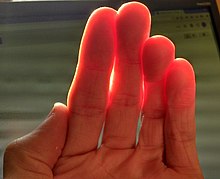
Back Volumenstreuung German اساسالتی Persian Transluminescence French サブサーフェス・スキャタリング Japanese 서브서피스 스캐터링 Korean Zemvirsmas izkliede Latvian/Lettish Подповерхностное рассеивание Russian Підповерхневе розсіювання Ukrainian 次表面散射 Chinese
This article needs additional citations for verification. (October 2017) |


Subsurface scattering (SSS), also known as subsurface light transport (SSLT),[1] is a mechanism of light transport in which light that penetrates the surface of a translucent object is scattered by interacting with the material and exits the surface potentially at a different point. Light generally penetrates the surface and gets scattered a number of times at irregular angles inside the material before passing back out of the material at a different angle than it would have had if it had been reflected directly off the surface.
Subsurface scattering is important for realistic 3D computer graphics, being necessary for the rendering of materials such as marble, skin, leaves, wax and milk. If subsurface scattering is not implemented, the material may look unnatural, like plastic or metal.
- ^ "Finish: Subsurface Light Transport". POV-Ray wiki. August 8, 2012.